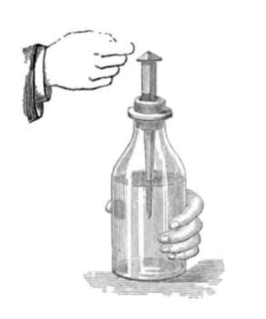
A Leyden jar is an antique electrical component which stores a high-voltage electric charge between electrical conductors on the inside and outside of a glass jar. It typically consists of a glass jar with metal foil cemented to the inside and the outside surfaces, and a metal terminal projecting vertically through the jar lid to make contact with the inner foil. It was the original form of the capacitor.

A perforation is a small hole in a thin material or web. There is usually more than one perforation in an organized fashion, where all of the holes collectively are called a perforation. The process of creating perforations is called perforating, which involves puncturing the workpiece with a tool.
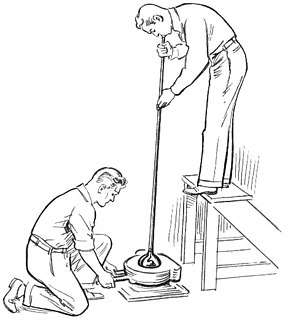
Glassblowing is a glassforming technique that involves inflating molten glass into a bubble with the aid of a blowpipe. A person who blows glass is called a glassblower, glassmith, or gaffer. A lampworker manipulates glass with the use of a torch on a smaller scale, such as in producing precision laboratory glassware out of borosilicate glass.
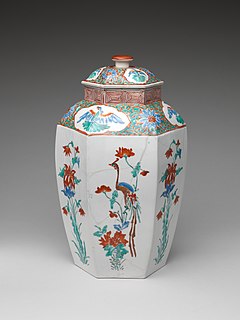
A jar is a rigid, cylindrical or slightly conical container, typically made of glass, ceramic, or plastic, with a wide mouth or opening that can be closed with a lid, screw cap, lug cap, cork stopper, roll-on cap, crimp-on cap, press-on cap, plastic shrink, heat sealed lidding film, an inner seal, a Tamper-evident band, or other suitable means.

A killing jar is a device used by entomologists to kill captured insects quickly and with minimum damage. The jar, typically glass, must be hermetically sealable and one design has a thin layer of hardened plaster of Paris on the bottom to absorb the killing agent. The killing agent will then slowly evaporate, allowing the jar to be used many times before needing to refresh the jar. The absorbent plaster of Paris layer also helps prevent the agent sticking to and damaging insects. Crumpled paper tissue is also placed in the jar for the same reason. A second method utilises a wad of cotton or other absorbent material placed in the bottom of the jar. Liquid killing agent is then added until the absorbent material is nearly saturated. A piece of stiff paper or cardboard cut to fit the inside of the jar tightly is then pressed in.

A materials recovery facility, materials reclamation facility, materials recycling facility or Multi re-use facility is a specialized plant that receives, separates and prepares recyclable materials for marketing to end-user manufacturers. Generally, there are two different types: clean and dirty materials recovery facilities.

Glass milk bottles are glass bottles used for milk and are generally reusable and returnable. Milk bottles are used mainly for doorstep delivery of fresh milk by milkmen: retail store sale is available in some regions. After customers have finished the milk they are expected to rinse the empty bottles and leave it on the doorstep for collection, or return it to the retail store. The standard size of a bottle varies with location, common sizes are pint, quart, Litre, etc.
Jared Crouch is a South Australian former Australian football player with the Sydney Swans of the Australian Football League (AFL), who is colloquially known as "Crouchie" to Swans fans and media. He currently serves as a development coach at the Sydney Swans.

A glass bottle is a bottle made from glass. Glass bottles can vary in size considerably, but are most commonly found in sizes ranging between about 200 millilitres and 1.5 litres. Common uses for glass bottles include food condiments, soda, liquor, cosmetics, pickling and preservatives. These types of bottles are utilitarian and serve a purpose in commercial industries.
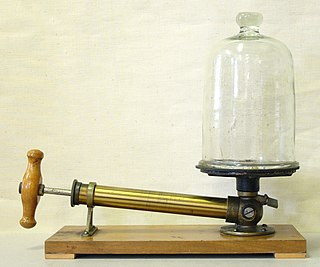
A bell jar is a glass jar, similar in shape to a bell, and can be manufactured from a variety of materials. Bell jars are often used in laboratories to form and contain a vacuum. It is a common science apparatus used in experiments. Bell jars have a limited ability to create strong vacuums; vacuum chambers are available when higher performance is needed. They have been used to demonstrate the effect of vacuum on sound propagation.

Sea glass and beach glass are similar but come from different types of waters. "Sea glass" is physically and chemically weathered glass found on beaches along bodies of salt water. These weathering processes produce natural frosted glass. "Genuine sea glass" can be collected as a hobby and is used for decoration, most commonly in jewelry. "Beach glass" comes from fresh water and in most cases has a different pH balance and a less frosted appearance than sea glass. Sea glass takes 20 to 40 years, and sometimes as much as 100 to 200 years, to acquire its characteristic texture and shape. It is also colloquially referred to as "drift glass" from the longshore drift process that forms the smooth edges. In practice, the two terms are used interchangeably.
"The Calzone" is the 130th episode of the NBC sitcom Seinfeld. This was the 20th episode of the seventh season. It aired on April 25, 1996. In this episode, George Costanza gets the ear of George Steinbrenner by having calzones for lunch with him, Elaine repeatedly goes out to dinner and movies with a guy who never actually asks her out, and Kramer heats his clothes in dryers and ovens.

Ground glass joints are used in laboratories to quickly and easily fit leak-tight apparatus together from commonly available parts. For example, a round bottom flask, Liebig condenser, and oil bubbler with ground glass joints may be rapidly fitted together to reflux a reaction mixture. This is a large improvement compared with older methods of custom-made glassware, which was time-consuming and expensive, or the use of less chemical resistant and heat resistant corks or rubber bungs and glass tubes as joints, which took time to prepare as well.
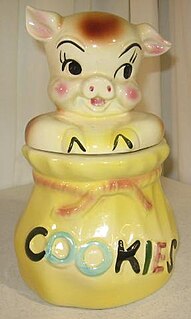
Cookie jars are utilitarian or decorative ceramic or glass jars often found in American and Canadian kitchens. In the United Kingdom, they are known as biscuit barrels or biscuit jars. If they are cans made out of tinplate, they are called biscuit tins. While used to store actual cookies or biscuits, they are sometimes employed to store other edible items like candy or dog treats, or non-edible items like currency.

A pull-tab is a gambling ticket that is sold as a means to play a pull-tab game. Other names for the game include Break-Opens, Nevada Tickets, Cherry Bells, Lucky 7s, Pickle Cards, Instant Bingo, Bowl Games, or Popp-Opens. Physical pull-tab tickets are multi-layered paper tickets containing symbols hidden behind perforated tabs. The object of the ticket is to open the perforated windows on the ticket and reveal a winning combination. The winning pull-tab ticket is turned in for a prize. Electronic analogues have also been created.
Jar burials are human burials where the corpse is placed into a large earthenware and then is interred. Jar-burials are a repeated pattern at a site or within an archaeological culture. When an anomalous burial is found in which a corpse or cremated remains have been interred, it is not considered a "jar burial".

A tip jar, also known as a tip cup is a container, commonly a glass jars, into which customers can put a gratuity. A tip jar is usually situated at the point-of-sale at many businesses. Although common in many countries around the world, tip jars in food and drink establishments are ubiquitous in the United States.

Through the Looking Glass, also known as Alice, was a 1984 video game written for the Apple Lisa and Apple Macintosh computers. Written by a member of the Lisa and Mac teams, Steve Capps, it was one of the earliest video games on the Mac platform, part of the only games disk officially sold by Apple Computer during that era.
The Philippines is an archipelago located in Southeast Asia and consists of 7,641 islands. Prehistoric beads are among the most significant resources deriving from the human past. They are artifacts that inform individuals about archaeological records. Beads play a vital role in Asian lives, since they were utilized as human markers to indicate a territory; moreover, prehistoric beads were significant for ancestors as well as the people who occupied the identical territory. For instance, if beads are perished or destroyed, they can be recovered archaeologically due to their durability, which allows for the preservation of these resources. Furthermore, several of the decorative pieces and tools that they possess, as well as their culture, seem to reflect this maritime characteristic. Due to the fact that beads are transportable, compact in size, and appealing to the eye, they can essentially be discovered all over the world. Tools such as choppers made of shells as well as decorative pieces like shell beads are common in Southeast Asian archaeological records due to this characteristic. Various sites have been found to contain shell beads, including Sucgang Barrio in Bohol; Sibale Island, near Surigao; Suluan island, south of Samar; Lagen Island in Palawan; and Camotes Islands.
The Noise is an American children's game show that aired on Universal Kids from October 23, 2017 to January 25, 2018. The series is presented by BattleBots ring announcer Faruq Tauheed.














